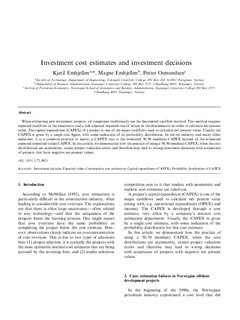Investment cost estimates and investment decisions
Journal article, Peer reviewed
Permanent lenke
http://hdl.handle.net/11250/2438543Utgivelsesdato
2002Metadata
Vis full innførselSamlinger
Originalversjon
Energy policy 30(2002), No. 2, p. 91-96 http://dx.doi.org/10.1016/S0301-4215(01)00065-9Sammendrag
When evaluating new investment projects, oil companies traditionally use the discounted cashflow method. This method requires expected cashflows in the numerator and a risk-adjusted required rate of return in the denominator in order to calculate net present value. The capital expenditure (CAPEX) of a project is one of the major cashflows used to calculate net present value. Usually the CAPEX is given by a single cost figure, with some indication of its probability distribution. In the oil industry and many other industries, it is a common practice to report a CAPEX that is the estimated 50/50 (median) CAPEX instead of the estimated expected (expected value) CAPEX. In this article, we demonstrate how the practice of using a 50/50 (median) CAPEX, when the cost distributions are asymmetric, causes project valuation errors and therefore may lead to wrong investment decisions with acceptance of projects that have negative net present values.
